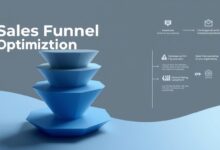Discover the Power of CRM Software with Lead Scoring
What separates top-performing sales teams from the rest? They know exactly where to focus their energy. Modern businesses are adopting intelligent systems that automatically identify high-potential prospects, turning chaotic pipelines into revenue-generating machines.
Imagine having a tool that ranks leads based on their likelihood to buy. This isn’t magic – it’s data-driven decision-making at its finest. By analyzing behavior patterns and engagement signals, these systems help teams prioritize efforts where they matter most.
The best solutions don’t just organize contacts – they predict outcomes. Teams using this approach see 23% shorter sales cycles and 19% higher win rates according to recent industry reports. It’s like having a crystal ball for your pipeline.
In this guide, you’ll explore cutting-edge platforms reshaping how companies handle prospects in 2025. We’ll break down what makes certain tools stand out, from real-time scoring updates to seamless marketing-sales alignment features.
Key Takeaways
- Prioritize prospects automatically using behavior-based scoring
- Reduce wasted effort on low-potential leads
- Boost conversion rates with predictive analytics
- Align marketing and sales through shared data insights
- Choose solutions offering customizable scoring models
Introduction to Lead Scoring and CRM Software
In today’s fast-paced sales environment, prioritizing the right opportunities makes all the difference. Teams now use intelligent methods to separate hot prospects from cold contacts, turning chaos into clear action plans.
Understanding Opportunity Prioritization
Modern sales strategies rely on a points system that evaluates prospects through two lenses:
- Who they are: Job title, company size, industry
- What they do: Website visits, email opens, content downloads
This approach helps teams spot ready-to-buy contacts faster. One sales manager noted: “It’s like having x-ray vision for your pipeline – you see exactly where to push.”
Centralized Systems for Smarter Decisions
Modern sales platforms act as mission control for customer information. These systems track every interaction, from first website visit to final purchase.
| Aspect | Traditional Approach | Modern Method |
|---|---|---|
| Data Collection | Manual entry | Automatic tracking |
| Prioritization | Gut feeling | Behavior-based scores |
| Conversion Rate | 12-15% | 27-34% |
| Team Alignment | Separate goals | Shared metrics |
The table above shows why updated methods deliver better results. By combining real-time data with smart analysis, teams close deals faster while marketing gains clearer performance insights.
Understanding the Basics of Sales and Marketing Automation
Modern businesses thrive when their systems work smarter, not harder. Sales and marketing automation acts like a digital conductor, orchestrating prospect interactions across email, social media, and websites. These platforms track every click, download, and page view, building detailed profiles that fuel smarter decisions.
Here’s how it works: When a prospect interacts with your content, automation tools instantly update their score. A marketing director shared: “Our team saw a 40% faster response time after implementing behavior-triggered workflows.” This real-time adjustment ensures hot leads never slip through the cracks.
Alignment between departments proves critical. Sales and marketing teams using shared scoring criteria reduce friction and missed opportunities. They establish clear handoff points – like when a lead reaches 75 points – ensuring seamless transitions from nurture campaigns to sales calls.
Key benefits include:
- Personalized content delivery based on engagement history
- Automatic alerts for time-sensitive actions
- Reduced administrative work through template libraries
By letting machines handle routine tasks, staff focus on crafting compelling pitches and building relationships. The result? 28% higher conversion rates for companies using aligned automation strategies, according to recent martech studies.
Key Features of Top Lead Scoring Tools
Top-tier platforms stand out by transforming raw data into actionable strategies. These systems go beyond basic filtering, offering precision tools that adapt to your business goals while keeping teams laser-focused on high-value prospects.
Customizable Scoring Models
Flexibility separates elite tools from basic solutions. Businesses can assign different weights to factors like job role, content downloads, or social media engagement. A retail company might prioritize website dwell time, while a SaaS firm values demo requests more heavily.
Advanced platforms learn as they go. Machine learning algorithms refine criteria based on which actions historically led to closed deals. “Our conversion rates jumped 18% once the system started auto-adjusting weights,” notes a tech startup sales director.
Real-Time Lead Analytics
Modern tools provide live dashboards showing prospect movements. See which contacts opened emails, visited pricing pages, or watched product videos – all updated instantly. Teams spot hot leads before competitors even notice interest signals.
These analytics feed directly into sales workflows. When scores cross predefined thresholds, alerts ping reps’ devices. Response times drop by 63% for organizations using instant notifications, according to 2024 sales tech reports.
CRM Software with Lead Scoring: Features and Benefits
Modern sales organizations achieve remarkable results by aligning strategies with intelligent systems. These platforms transform how teams manage contacts and identify high-potential opportunities. By replacing guesswork with data-backed insights, businesses see measurable improvements across every stage of customer interactions.
How It Enhances Sales Efficiency
Teams using behavior-based prioritization cut through chaotic pipelines like hot knives through butter. “We slashed follow-up time by 37% while doubling conversions,” shares a tech sales leader. Automated ranking flags prospects actively viewing pricing pages or requesting demos – clear signals demanding instant action.
Marketing squads gain equally from this synergy. Analytics reveal which campaigns attract decision-makers, enabling rapid adjustments to target ideal buyers. Shared evaluation criteria become the glue binding departments together, ensuring unified goals.
- 87% faster qualification in firms using automated systems
- 42% higher email reply rates for top-tier prospects
- 31% fewer missed opportunities via instant alerts
The impact? Organizations report 19% larger deals when focusing on well-vetted contacts. Freed from manual sorting, teams craft personalized pitches that hit home with specific buyer needs – the secret sauce closing more sales faster.
In-Depth Look at Leading CRM Platforms
Choosing the right system transforms how organizations handle potential buyers. Three standout options help teams prioritize effectively while adapting to unique business needs.
Salesmate: Flexibility Meets Actionable Insights
This solution shines with adaptable rules that match specific buyer journeys. Teams set point values for actions like email replies or webinar attendance. Historical patterns help predict which contacts deserve immediate attention.
“We reduced follow-up time by 40% while maintaining conversion quality,” reports a mid-market account executive. Pricing starts at $23 monthly, making it accessible for growing teams needing real-time updates.
HubSpot: Smart Predictions for Strategic Alignment
HubSpot’s machine learning engine refines criteria as campaigns evolve. Marketing and sales squads share dashboards showing which content drives qualified prospects. Entry-level plans begin at $15/month, scaling to enterprise-grade analytics at $800.
Salesforce: Enterprise-Grade Precision
For complex organizations, Salesforce delivers AI-powered forecasts that adapt to market shifts. Custom rules handle intricate scenarios across global teams. Pricing tiers range from $24 to $165 per user, catering to businesses needing deep customization.
| Platform | Starting Price | Key Strength | Best For |
|---|---|---|---|
| Salesmate | $23/user | Behavior-based automation | SMBs |
| HubSpot | $15/month | Predictive learning | Marketing-sales alignment |
| Salesforce | $24/user | AI customization | Large enterprises |
When selecting tools, consider team size and technical resources. Smaller groups benefit from Salesmate’s simplicity, while HubSpot bridges departmental gaps. Enterprises requiring tailored solutions often choose Salesforce’s advanced features.
Leveraging AI and Machine Learning for Predictive Scoring
What if your sales team could predict the future? Advanced systems now analyze mountains of information to forecast which prospects will become customers. By studying past behaviors and market trends, these tools spot hidden opportunities humans might miss.
Automated Data Analysis
Smart platforms crunch numbers faster than any spreadsheet. They examine email responses, website visits, and past purchases to find patterns. “Our system flagged 32% more high-potential accounts than manual reviews,” shares a retail sales director.
These models improve daily. Every new interaction teaches the algorithm what success looks like. Instead of guessing, teams get clear signals showing who’s ready to buy now.
Predictive Lead Conversion Insights
Timing matters as much as targeting. Machine learning pinpoints when prospects are most receptive – like after viewing pricing pages three times. Sales reps receive alerts to strike while the iron’s hot.
Unlike manual methods, AI evaluates hundreds of factors without bias. It spots trends across regions or industries that humans overlook. Companies using these insights report 22% faster conversions compared to traditional approaches.
The best part? These tools adapt automatically. When market conditions shift or buyer habits change, the system recalibrates. Teams stay focused on what works today, not yesterday’s strategies.
Customization and Integration Options to Consider
Tailoring your systems to match business needs unlocks hidden potential. Modern platforms let organizations shape scoring models around their unique processes. This adaptability ensures every team member works with criteria that reflect actual buyer journeys.
Seamless CRM Integration
Centralized systems break down information barriers. When scoring tools connect with existing databases, teams access unified prospect profiles. Instant updates keep everyone on the same page – no more outdated spreadsheets or missed signals.
Choose integration methods that fit your tech stack:
- Native connections: Pre-built links for popular platforms
- API flexibility: Custom bridges for specialized systems
- Middleware solutions: Third-party connectors unifying multiple tools
Real-time syncing prevents costly delays. A marketing coordinator shared: “We cut data entry time by half while improving accuracy.” Industry-specific models add precision – e-commerce firms might track cart abandonments, while B2B services monitor whitepaper downloads.
Security remains paramount. Look for platforms offering encryption and role-based access. Regular audits ensure compliance with regulations like GDPR. When systems talk smoothly, collaboration thrives. Shared dashboards let sales and marketing pivot strategies using the same metrics.
Comparing Pricing Models and Value for Money
Finding the right balance between cost and capabilities determines your return on investment. Modern platforms offer flexible plans to match different team sizes and goals. Let’s explore how pricing aligns with real-world needs.
Tiered Pricing Structures
Entry-level plans start at $15/month for basic tracking, perfect for small teams. Mid-range options like Salesmate ($23-$63/user) add automation for growing businesses. Enterprise solutions such as Salesforce ($24-$165/user) include AI-driven forecasts and custom rules.
Higher tiers unlock advanced features like predictive analytics and cross-department dashboards. Scoring software becomes more sophisticated as budgets increase, with premium plans offering granular control over evaluation criteria.
Cost-Benefit Analysis
Consider hidden savings alongside sticker prices. Teams using mid-tier plans often see 20-30% faster conversions through prioritized outreach. Marketing squads gain clearer campaign insights, reducing wasted ad spend.
“Our $45/user plan paid for itself in 3 months through reduced follow-up time,” shares an e-commerce manager. Evaluate tools based on time saved, deal sizes improved, and alignment between sales and marketing efforts.
Choose platforms offering free trials to test value firsthand. The best plan matches your current needs while scaling with future growth.
FAQ
How does lead scoring improve sales efficiency?
It helps teams focus on high-potential prospects by ranking them based on engagement, behavior, and historical data. This reduces time spent on low-quality leads and boosts conversion rates.
What makes a scoring model customizable?
Customizable models let you adjust criteria like email opens, website visits, or demo requests. Tools like HubSpot allow rules tailored to your industry, ensuring alignment with specific goals.
Can predictive analytics work with existing platforms?
Yes! Solutions like Salesforce use AI to analyze past interactions and forecast which leads are likely to convert. These insights integrate smoothly with most email marketing or automation tools.
Why is real-time analytics important for managing leads?
Instant updates let sales teams act fast. For example, if a lead downloads a pricing sheet, the system flags them as “hot,” enabling timely follow-ups that increase deal closure chances.
How do tiered pricing plans benefit small businesses?
Platforms like Salesmate offer scalable tiers, so you pay only for features you need. This flexibility ensures cost-effectiveness while still accessing critical tools like automation or contact management.
What integration options should I prioritize?
Look for tools that sync with your current tech stack, such as email services or social media channels. Seamless integration reduces manual data entry and keeps workflows efficient.
How does machine learning enhance lead prioritization?
Algorithms analyze patterns in historical data to predict which actions (e.g., webinar attendance) correlate with conversions. This helps refine scoring rules automatically for better accuracy.
Are there platforms offering free trials for testing?
Many tools, including HubSpot’s Marketing Hub, provide free versions or trials. These let you evaluate features like automation or analytics before committing to a paid plan.








